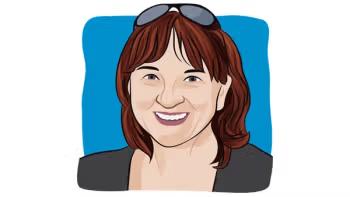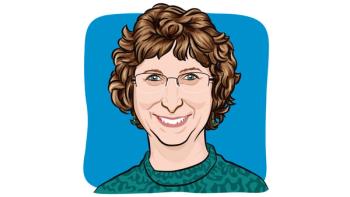
- Breast Cancer Special Issue 2019
- Volume 1
- Issue 1
From One to Many: The Growing Treatment Landscape of HER2-Positive Breast Cancer
Two decades ago, a patient with HER2-positive breast cancer had a single targeted drug option. Now a plethora of new and emerging treatments fill the landscape.
As 2017 came to a close, Lacy Gulley had plenty to look forward to in the new year. The 31-year-old from Athens, Georgia, had been recently engaged to her boyfriend Jay, and they were busy planning their March 2018 wedding. Everything was going swimmingly — until what she assumed was a benign lump in her breast turned out to be an aggressive form of breast cancer.
Over the summer, Gulley had noticed a hard lump in her right breast. Having experienced fibroadenomas — benign, noncancerous breast lesions — in the past, she mostly ignored it. During Gulley’s annual gynecological exam in November, even her doctor didn’t seem too concerned but asked her to keep an eye on it for the next few weeks. When the lump hadn’t gone away by December, Gulley scheduled a mammogram and ultrasound.
“Although I didn’t officially get the diagnosis until January 2018, they were already 100% sure that it was cancer,” says Gulley, now 33. “I have no family history of breast cancer whatsoever, and I thought at the time that breast cancer was always hereditary, so it was very shocking. Getting that news is really overwhelming, and I had no idea what was to come.”
Because of her young age, her doctors wanted to start treatment right away. They took three biopsies, which revealed a subtype of breast cancer known as HER2 positive. Women with HER2-positive breast cancers have tumors with higher levels of a growth-promoting protein called HER2, which stands for “human epidermal growth factor receptor 2.” As a result, these cancers grow and spread more aggressively than other types of breast cancer. About one out of every five breast cancers has extra copies of the HER2 gene (known as gene amplification) that leads to an overexpression (high levels) of the HER2 protein.
Jennifer Campisano received a diagnosis of HER2- positive breast cancer in 2011, also at an early age. HER2- positive status is more common among younger patients with breast cancer, with mutation incidence at 29.9% in patients ages 15 to 29 and 25.5% in those ages 30 to 39. When Campisano was 32, she and her husband, Chris, had their first child, a boy named Quinn. When he was just 3 1/2 months old, Campisano noticed a walnut-size lump in her right breast.
After two OB-GYNs told her it was probably nothing, she eventually saw a surgeon who sent her straight to the radiology department for a mammogram and ultrasound.
“In my head, I still wasn’t thinking cancer, but the radiologist told me, ‘I’m 99% sure this is cancer,’” says Campisano, who lives in Phoenix. “After the biopsies, they called me and confirmed that it was HER2-positive breast cancer. It was rough. I had to wean my son overnight, which was really painful.”
Fortunately, the treatment landscape for this type of disease has evolved considerably over the past two decades, with the development of drugs that target the HER2 protein. Even today, treatment options continue to emerge for patients like Campisano and Gulley, who both received newer agents as part of their regimens for earlier-stage disease and remain cancer-free.
“In the past, HER2-positive breast cancer was known as a more aggressive disease with a worse prognosis than HER2-negative breast cancer,” says Dr. Janice Lu, clinical professor of medicine at the University of Southern California Norris Comprehensive Cancer Center. “But with the development and approval of five drugs now that specifically target HER2, being HER2 positive is no longer any worse for patients than being HER2 negative.”
In clinical trials, researchers are testing several other agents for HER2-positive breast cancer with a high likelihood of approval by the Food and Drug Administration (FDA). They are mostly focused on treating patients in the metastatic setting, meaning the disease has spread beyond the breast, and those whose disease is resistant to more commonly used drugs.
A LARGE TOOLBOX OF TREATMENTS
In 1987, oncologist Dr. Dennis Slamon at UCLA discovered that the HER2 protein was present at high levels in certain breast cancers. The protein is also found on the surface of normal breast cells, but some breast cancer cells have 40 to 100 times more HER2, which stimulates the tumor cells to divide and grow. This overexpression of HER2, which became known as “HER2 positivity,” was linked to a higher likelihood of metastasis and relapse in patients, along with a decrease in overall survival, or the length of life measured from the start of treatment.
After this discovery, Slamon and his colleagues had a novel idea: What if HER2 protein’s activity could be blocked? Shouldn’t that, in theory, halt the aggressive growth of the cancer cells? This train of thought led to the groundbreaking development and FDA fast-track approval of the first drug to target HER2 in 1998. In fact, it was the first drug to target a protein that contributes to the development and growth of any cancer: Herceptin (trastuzumab).
Herceptin is a monoclonal “humanized” antibody, a laboratory-created molecule that attaches to cancer cells, inhibits the growth factor function of HER2 and attracts attack by the immune system. In a phase 3 clinical trial, adding Herceptin to chemotherapy was associated with more responses, longer time until cancer progression and better survival in patients with metastatic HER2-positive breast cancer compared with chemotherapy alone. In 2006, it was approved with chemotherapy for use after surgery, to help prevent recurrence, in earlier-stage HER2-positive breast cancers.
Herceptin is generally well-tolerated, causing mild to moderate side effects such as muscle aches, dizziness, headache, fever/chills and runny nose. However, it does come with a small risk of cardiotoxicity — especially for women who were also treated with anthracycline chemo- therapy — which usually manifests as cardiac dysfunction, primarily a condition known as cardiomyopathy, which can lead to congestive heart failure.
“We are getting long-term data on outcomes with trastuzumab after its FDA approval 20-plus years ago, and today if women are diagnosed with HER2-positive breast cancer, we can tell them their prognosis is as good as those with HER2- negative disease,” says Dr. Sara Hurvitz, a medical oncologist at UCLA. “Although trastuzumab has leveled the playing field, it isn’t a cure for 100% of patients by any means. For early-stage cancer that recurs as metastatic disease, trastuzumab can improve outcomes and help patients live with the disease, but it does not cure, for the most part.”
More recently, patients have also benefited from a newer HER2-targeting therapy called Perjeta (pertuzumab), which was approved in 2012. Similar to Herceptin, Perjeta is a monoclonal antibody that attaches to HER2 receptors on the surface of breast cancer cells and prevents them from receiving growth signals. It targets a different area on the HER2 receptor than Herceptin, which means it can act as a complementary treatment or serve as an alternative therapy for Herceptin-resistant disease.
This drug is used in both earlier-stage and metastatic HER2-positive breast cancers.
For women with early-stage HER2-positive breast cancer, the standard of care is currently chemotherapy plus Herceptin. Typical chemotherapy regimens include AC-TH, or Adriamycin (doxorubicin) and Cytoxan (cyclophos- phamide), followed by a taxane that is given concurrently with Herceptin. Recently, it has become more common to use TCHP, which includes docetaxel and carboplatin given concurrently with Herceptin and Perjeta.
This minimizes the cardiac risks associated with Adriamcyin along with Herceptin. Patients on either regimen will end with Herceptin (and Perjeta if used with chemotherapy) after completing the chemotherapy portion, such that a full year of antibody therapy is given.
In the metastatic setting, the standard of care for initial treatment is a combination of Herceptin, chemotherapy and Perjeta. Studies have found that 15% to 25% of patients with early-stage, HER2-positive breast cancer eventually experience metastatic recurrence after initial treatment. Then, the prognosis is poor, with most recurrences involving incurable metastatic disease, although some patients can survive for many years with their cancer controlled by several available medications.
“In the metastatic setting, we’re not curing the vast majority of patients with HER2-positive disease, and resistance does occur,” says Dr. Sara Tolaney, associate director of the Susan F. Smith Center for Women’s Cancers at Dana-Farber Cancer Institute in Boston. “But patients continue to live longer because they can go from one treatment to the next. There are now multiple options to go to as resistance develops, and there are also clever ways to overcome resistance.”
In 2012, Campisano started the TCH regimen along with surgery and radiation therapy. When it looked like her cancer recurred, her doctors gave her newly approved Perjeta, along with Herceptin and chemotherapy. Less than a week after her 2018 wedding, Gulley was also treated with Perjeta in conjunction with the AC-TH regimen following her mastectomy. The agent had already been approved for more than five years to treat both metastatic HER2-positive breast cancer and early-stage disease prior to surgery, and in 2017 it won approval to be given after surgery for early-stage disease.
“I was on Perjeta for a year, and my doctors warned me about diarrhea being a common side effect,” Gulley says. “I definitely noticed that in the beginning of treatment, but my body got used to it, I guess, because at the end of the year, I wasn’t as bad. I used over-the-counter Imodium and things like that to combat it.”
With the combination of Perjeta and Herceptin, Campisano experienced very mild side effects — itchy skin and a runny nose — but they were nothing compared to how she felt during chemotherapy. Unfortunately, her scans still showed what looked like cancer after her initial treatment, so she started on Kadcyla (ado-trastuzumab emtansine, also known as T-DM1).
Kadcyla is a type of antibody-drug conjugate, an emerging class of agents comprised of an antibody linked to a highly potent anti-cancer drug. They combine the heat-seeking ability of targeted therapy with the cancer-killing power of chemotherapy. In 2013, Kadcyla was approved for patients with metastatic HER2- positive breast cancer who were previously treated with Herceptin and taxanes. Earlier this year, it gained approval for use in the adjuvant (postsurgical) setting for early-stage disease. Common side effects include fatigue, nausea, bone and joint pain, muscle pain and constipation.
In the phase 3 KATHERINE study, Kadcyla given after surgery significantly reduced the risk of invasive breast cancer recurrence or death from any cause by 50% compared with Herceptin in patients who had residual disease after neoadjuvant (presurgical) therapy. An analysis showed that of 1,486 patients in the trial, 165 in the Herceptin group and 91 in the Kadcyla group had experienced invasive disease or death. In addition, at three years, 88.3% of those who took Kadcyla versus 77% of those who took Herceptin were free of invasive disease.
Campisano took Kadcyla for almost three years. In 2016, a lung biopsy revealed that what had appeared to be cancer in her lungs was actually an autoimmune disease that can mimic cancer on scans. She was taken off treatment and finally tested cancer-free. Even if she didn’t need T-DM1, she refers to it as “a wonder drug.”
Another option in both early-stage and metastatic HER2- positive breast cancer is Nerlynx (neratinib). In early-stage disease, the drug is approved for extended postsurgical therapy after chemotherapy and Herceptin to reduce the risk of recurrence. Nerlynx is a kinase inhibitor, which blocks enzymes that promote cell growth. Specifically, it inhibits the activity of HER2 and other enzymes in its family. In a phase 3 clinical trial, 94% of those who took Nerlynx experienced no disease progression over two years versus 91% in a placebo group. Common side effects included diarrhea, vomiting and nausea.
The results from a more recent phase 2 trial showed that combining Nerlynx with a chemotherapy drug called capecitabine has an effect on patients with HER2-positive breast cancer who have brain metastases.
“Neratinib is notable because it has activity with HER2- positive brain metastases, which occurs in about 50% of patients with metastatic disease,” Tolaney says. “It already has FDA approval in the adjuvant setting for patients who have completed a year of trastuzumab, and it will likely get approval in the near future for the metastatic setting based on the results of the trial.”
Finally, the kinase inhibitor Tykerb (lapatinib) was approved in 2007 for the first-line treatment of HER2-positive metastatic breast cancer, first with the chemotherapy Xeloda (capecitabine) and later with the hormone-blocking drug letrozole for postmenopausal women with hormone-driven breast cancer that over- expresses the HER2 receptor. A 2009 study showed that adding Tykerb was associated with a 5.2-month increase in median time without disease progression compared with taking letrozole alone (8.2 months with the drug combination versus 3.0 months with letrozole only).
NEW DRUGS HOLD PROMISE
“Patients have a lot of options, and there are multiple new therapies in clinical trials, some of which are very prom- ising,” Hurvitz says. “Three in particular deserve mention: tucatinib, a pill that appears to be safer than neratinib and lapatinib because it doesn’t cause as much diarrhea; DS-8201, another antibody-drug conjugate with a different chemo payload than Kadcyla; and margetuximab, which is similar to trastuzumab.”
All three investigational agents have shown tremendous promise in fighting HER2-positive disease and are expected to gain FDA approval in the near future. The HER2CLIMB trial is currently investigating tucatinib, a HER2-specific tyrosine kinase inhibitor, with Herceptin and
capecitabine in patients with metastatic HER2-positive breast cancer. It can penetrate the blood-brain barrier better than antibody drugs like Herceptin and Perjeta and demonstrated a brain-specific response in five of 12 patients with brain metastases. Hurvitz expects tucatinib
to gain FDA approval within the next six to 12 months.
DS-8201 (trastuzumab deruxtecan) links Herceptin with a chemotherapeutic drug — a topoisomerase inhibitor called deruxtecan, which interrupts DNA replication in cancer cells and is “guided” more specifically to HER2-positive cells while mostly sparing normal cells.
The FDA granted this experimental antibody-drug conjugate breakthrough therapy designation, expediting its development and review, as a potential treatment for patients with HER2-positive, locally advanced or metastatic breast cancer who have been previously treated with Herceptin and Perjeta and have disease progression after T-DM1. In a phase 1 study, 54.5% of HER2-positive women treated with DS-8201 saw their cancer respond to the drug.
“DS8201 is an up-and-coming drug that everyone is very excited about. It delivers a different payload into the cancer cell than TDM-1 and also uniquely allows for the bystander effect,” Tolaney said. “This means that some of the drug that enters one cancer cell can pass through its cell membrane into neighboring cancer cells, which then kills them.”
A more recently studied monoclonal antibody, margetuximab, has been described as an optimized version of Herceptin. A section of the antibody was engineered to better engage the immune system in fighting the disease. In the phase 3 SOPHIA trial, patients with metastatic HER2-positive breast cancer who took the investigational drug with chemotherapy had a median progression-free survival of 5.8 months compared with 4.9 months for those treated with Herceptin and chemotherapy.
“These new drugs are rising stars in the metastatic setting, and many other agents are currently being tested,” Lu says. “Patients with HER2-positive breast cancer should discuss with their doctors what is the standard of care, next steps for treatment, any clinical trials that are potentially available and, of course, possible side effects.”
Although they continue to adjust to a new normal after cancer, Gulley and Campisano are grateful to be cancer-free and hopeful about the growing availability of treatment options for their disease. Gulley had a left-side mastectomy in February of this year, after a mammogram revealed calcifications in her remaining breast. She was also put into a chemical menopause at age 33, which means hot flashes, night sweats and fatigue.
“After my wedding, instead of going on a honeymoon, I started my chemotherapy. This has all been such a whirlwind,” Gulley said. “Being newly married, it’s really hard. Menopause has a lot of bad side effects, sexually and otherwise. That fear of recurrence is always there too, but I’m so thankful for the two medicines that were available to treat me.”
Campisano also went through early menopause, induced by chemotherapy. She eventually emerged from that menopause and, surprisingly, became pregnant with her second child. But the chaos of having a newborn, then a cancer diagnosis and treatment, followed by another baby left her physically and mentally exhausted.
“I don’t think I had time to process anything in the beginning. My husband and I had not even been married three years when I was diagnosed, and today I’m left with range-of-motion issues, body image issues, a bilateral mastectomy and post-traumatic stress disorder,” Campisano says. “I know that we don’t have a cure for metastatic HER2-positive breast cancer, but it’s wonderful that these new drugs do work for some people.”
Articles in this issue
about 6 years ago
Suspending Judgement During Cancer Treatmentabout 6 years ago
Bending the Rules in Lymphedemaabout 6 years ago
Is Genetic Testing Worth the Time?about 6 years ago
Feeling Like New After Mastectomyabout 6 years ago
Pairing Up Against Triple-Negative Breast Cancerabout 6 years ago
Getting Under Your Skin with Tamoxifen Gelabout 6 years ago
A Brighter Outlook for Metastatic Breast Cancerabout 6 years ago
Following the Clues With Liquid Biopsiesabout 6 years ago
New Drug Pipeline for HER2-Positive Treatment Expands



